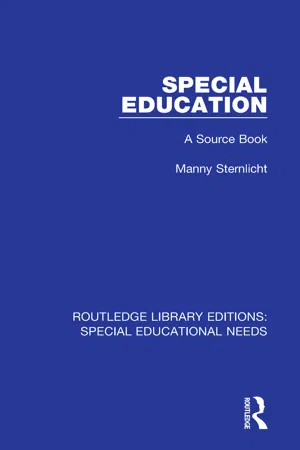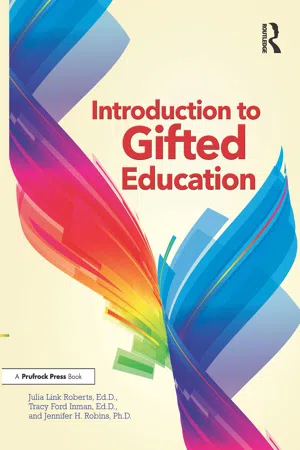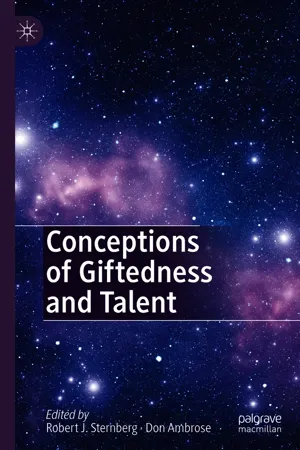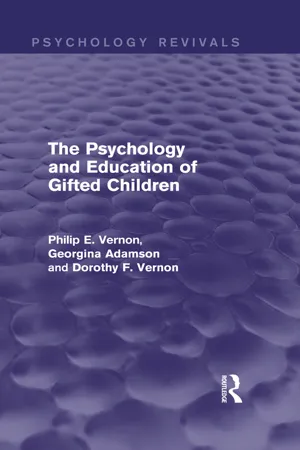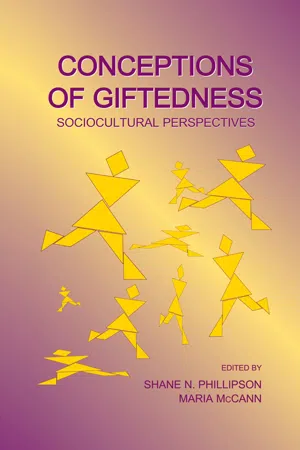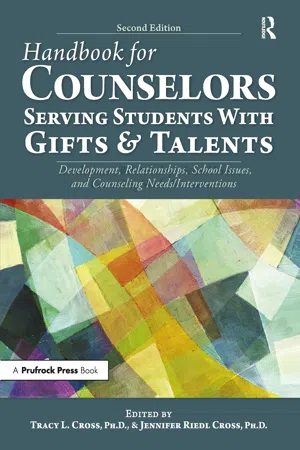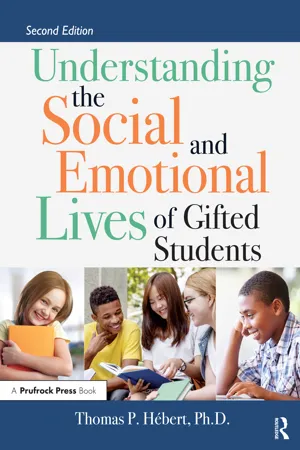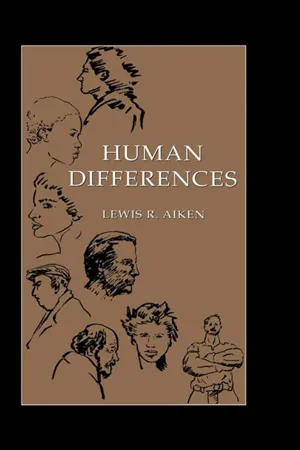Psychology
Intellectual Giftedness
Intellectual giftedness refers to exceptional cognitive abilities, often characterized by high IQ scores and advanced problem-solving skills. Individuals with intellectual giftedness may demonstrate exceptional talents in areas such as mathematics, language, or the sciences. This concept is important in understanding the unique cognitive and educational needs of gifted individuals.
Written by Perlego with AI-assistance
Related key terms
Related key terms
1 of 4
Related key terms
1 of 3
10 Key excerpts on "Intellectual Giftedness"
- eBook - ePub
Special Education
A Source Book
- Manny Sternlicht(Author)
- 2018(Publication Date)
- Routledge(Publisher)
CHAPTER II:GIFTEDNESSOn the other side of the spectrum of cognitive functioning (two standard deviations above the mean) are the gifted and talented children (IQs above 130) who are blessed with special abilities, but who are frequently overlooked when it comes time to provide special classes. The overall misconception is that gifted or exceptionally creative children can progress and develop on their own. This is no more true for these children than it is for any other group of children. The gifted are considered exceptional children because regular classroom instruction fails to satisfy their needs to fulfill their potential. They are in need of additional services, programs that are enriched, creative, and advanced. The gifted frequently are not viewed as handicapped or exceptional, which may explain why some administrators fail to provide specialized programs for the gifted within their district. Then, too, giftedness is not limited only to academic achievement per se; children can be creatively gifted, psycho-socially gifted, and kinesthetically gifted.For purposes of federal funding, giftedness is defined in PL 91–230 as follows: Gifted and talented children are those identified by professionally qualified persons who, by virtue of outstanding abilities, are capable of high performance. These are children who require differentiated educational programs and/or services beyond those normally provided by the regular school program in order to realize their contribution to self and society. Children capable of high performance include those with demonstrated achievement and/or potential ability in any of the following areas, singly or in combination: general intellectual ability, specific academic aptitude, creative productive thinking, leadership ability, visual and performing arts, psychomotor ability. It is difficult to determine the exact percentage of children who are gifted. Owing to the lack of programs for the gifted, many such children go unnoticed and many talents remain undeveloped. Our best guesstimate of prevalence is that the gifted constitute two to four percent of the total school population. - eBook - ePub
- Julia Link Roberts, Tracy Ford Inman, Jennifer Robins(Authors)
- 2021(Publication Date)
- Routledge(Publisher)
Through the work of numerous researchers and theorists, a great deal has been discovered about the development of children, including what to expect physically, cognitively, socially, and emotionally of a child of a specific age. These four areas of development are interwoven and proceed at a similar rate. Although every child with typical development does not reach the same developmental benchmark at the same time, there are fairly narrow windows and stages through which children develop. For a gifted child, her development is often out of sync with other children her age. Her physical, cognitive, social, and emotional development progress at different rates. This asynchronous development is the basis of the 1991 Columbus Group definition of giftedness:Giftedness is asynchronous development in which advanced cognitive abilities and heightened intensity combine to create inner experiences and awareness that are qualitatively different from the norm. This asynchrony increases with higher intellectual capacity The uniqueness of the gifted renders them particularly vulnerableTable 4.2 Potential ProblemsStrengths Possible Problems Acquires and retains information quickly Impatient with slowness of others; dislikes routine and drill; may resist mastering foundation skills; may make concepts unduly complex Inquisitive attitude; intellectual curiosity; intrinsic motivation; searches for significance Asks embarrassing questions; strong willed; excessive in interests; expects same of others Ability to conceptualize, abstract, synthesize; enjoys problem-solving and intellectual activity Rejects or omits details; resists practice or drill; questions teaching practices Can see cause-effect relations Difficulty accepting the illogical, such as feelings, traditions, matters to be taken on faith Love of truth, equity, and fair play Difficulty in being practical; worries about humanitarian concerns Enjoys organizing things and people into structure and order; seeks to systemize Constructs complicated rules or Systems; may be seen as bossy, rude, or domineering Large vocabulary and facile verbal proficiency; broad information in advanced areas May use words to escape or avoid situations; becomes bored with school and age peers; seen by others as a "know-it-all" Thinks critically; has high expectations; is self-critical and evaluates others Critical or intolerant toward others; may become discouraged or depressed; perfectionistic - eBook - ePub
- Robert J. Sternberg, Don Ambrose, Robert J. Sternberg, Don Ambrose(Authors)
- 2020(Publication Date)
- Palgrave Macmillan(Publisher)
sui generis . The greatest creators and leaders make their own standards to be judged by. To modify slightly a famous quotation from Arthur Schopenhauer, “[Giftedness] hits a target no one else can hit; Genius hits a target no one else can see.”Practical Implications
The three definitions presented above have some useful repercussions. These are concisely summarized in Table 22.1 . Let me now walk my readers through the rows.Table 22.1 Contrasts among the three concepts on five criteriaCriterion Giftedness Talent Genius High IQ required? Only if intellectual Depends on domain Depends on domain Nature or nurture? Implicitly both Explicitly nature Implicitly both Place in life span? Childhood/adolescence Entire life span Adulthood Identification? If standardized norms Rather difficult today Best if posthumously Intervention? Education and training Impractical/unethical Very difficult High IQ Required?
Performance on an IQ test, or even a retrospective IQ estimate, has a variable connection with the three concepts. In the case of giftedness, a high IQ would prove most relevant when giftedness is defined as a score at some high percentile, such as the 1% criterion used by Terman (1925–1959 ). Yet in light of the research conducted since then, performance on an IQ test need not provide the only criterion. A case in point is those attempts to define other intelligences that are not very compatible with the analytical abilities emphasized on such tests (e.g., Gardner, 1983 ; Sternberg, 2004 ). Indeed, giftedness can be assessed without using any psychometric instrument whatsoever, as is the case in artistic and athletic giftedness. Often competitions - eBook - ePub
Positive Psychology
The Science of Wellbeing and Human Strengths
- Alan Carr(Author)
- 2022(Publication Date)
- Routledge(Publisher)
Sternberg’s view that giftedness involves a synthesis of wisdom, intelligence, and creativity.Wisdom:Expert decision-making ability in addressing complex social problems in a reflective, prosocial, and emotionally balanced way, marked by a tolerance for uncertainty, value relativity, openness, spirituality, and a sense of humour about oneself.Wise reasoning:Grossman’s conception of wisdom as an advanced stage of cognitive development marked by intellectual humility, a recognition of the possibility of uncertainty and change, an openness to multiple perspectives, and an openness to integrating different perspectives to find a wise solution.Personal development questions
- Describe a situation that occurred within the past month in which you successfully found a creative solution to a difficult problem or made a wise judgement.
- What skills did you use to do this?
- Describe a situation that occurred within the past month in which it was critical for you to find a creative solution to a difficult problem or to make a wise judgement, but you were not successful in doing so.
- What skills would you like to have had so that you could have found a creative solution or made a wise judgement?
- What steps can you take now to develop these skills?
- What would be the costs and benefits of taking these steps?
- Take some of these steps and assess the impact this has on your wellbeing by assessing yourself before and afterwards on the one of the wellbeing scales contained in Chapter 1.
Essay questions
- Compare and contrast giftedness, creativity, and wisdom in terms of definition, assessment, theories, and main research findings.
- What do you consider to be the most important research findings on giftedness, creativity, wisdom, growth mindset, and grit?
Research question
Conduct a PsycINFO search covering literature published in the past couple of years using the terms relevant to issues covered in this chapter, such as giftedness, creativity, wisdom, growth mindset, and grit. Identify a study that interests you and that is feasible to replicate and extend. Conduct the replication. - eBook - ePub
- Philip E. Vernon, Georgina Adamson, Dorothy F. Vernon(Authors)
- 2013(Publication Date)
- Routledge(Publisher)
2 Giftedness and intelligenceNo two gifted children are the same in their abilities, talents and personalities. Nevertheless, a very large proportion are distinguished from average children by virtue of superior general intelligence; and this can be measured fairly reliably by an individual test as the Stanford-Binet or Terman-Merrill scales, or by one of the Wechsler scales (WPPSI, WISC or WAIS1 ). We will comment later on the use and interpretation of intelligence quotients obtained from these or other tests. Some gifted children, however, are characterized more by specialized abilities or talents, for example in mathematics, science, mechanical construction, art or music and so forth (cf. chapter 4 ) than by very high general intelligence, though this also will usually be well above average. Giftedness then is a good deal broader and more varied than just IQ. But intelligence is such a crucial quality, and so much is known about its origins and development, that this chapter and the next one will be devoted mainly to it.Growth of intelligenceFirst let us ask, how early in life can superior intelligence be recognized? It is very natural that fond parents should observe their baby’s development intently, and often seize on each new activity or growth as a sign of exceptional ability. But in fact there are scarcely any trustworthy signs of later ability during the first year, and not much that can be relied on in the second and third years. The first couple of years, according to Piaget, constitute the sensory-motor stage during which the child is growing physically, learning to coordinate his senses and movements, learning to recognize and react to objects, people, sounds and words. It is essentially a practical stage in which be becomes remarkably competent in handling concrete everyday situations, e.g. manipulating things and moving around, and in beginning to use speech as a means of communication. But although children vary very considerably in the rate at which these capacities mature, they give virtually no indication of later intelligence. During the second year it is obvious that children are beginning to remember things, and anticipate through some kind of mental imagery; also they can form concepts such as pleasant v - eBook - ePub
Conceptions of Giftedness
Socio-Cultural Perspectives
- Shane N. Phillipson, Maria McCann(Authors)
- 2020(Publication Date)
- Routledge(Publisher)
Even though Gardner’s theory has had an important influence in the broadening of educators’ views of intelligence, various criticisms have been proposed. First, there currently exists no published empirical test of the theory as a whole. Second, the intelligences that Gardner proposes are based on selective literature that supports his hypothesis. Also, the literature he used is distinctly different from the psychometric literature, which was specifically designed to test psychometric theories of intelligence. Third, even though assessments exist to test the various intelligences (e.g., Gardner, Feldman, & Krechevsky, 1998), they have not proven to be psychometrically valid. There is some evidence to suggest, however, that they are of acceptable reliability (Plucker, Callahan, & Tomchin, 1996). Without valid tests though, it is difficult to evaluate the success of interventions. Lastly, it is not clear that the different intelligences are truly separate from one another and that each serves an independent adaptive function.Abraham Tannenbaum’s Psychosocial Definition
Abraham Tannenbaum proposed a psychosocial definition that synthesizes a large amount of literature on the contributing factors linking the promise to the fulfillment of giftedness. In presenting his psychosocial definition of giftedness, Tannenbaum made a clear distinction between child precocity and adult giftedness (Tannenbaum, 1986). He argues that children cannot be evaluated on universal criteria of giftedness (such as that judged by an adult expert in a field) but must only be compared with others of their age. According to Tannenbaum, early schooling is reservedly for consuming knowledge, whereas producing knowledge comes later in a person’s growth cycle.For the student with great potential to become a producer of knowledge, his or her internal qualities need to interact with external conditions. Tannenbaum proposed five psychological and social links between promise and fulfillment. They are superior intelligence, exceptional special aptitudes, nonintellective facilitators, environmental influences, and chance, or luck. These five factors are posited to interact to produce high levels of productivity, and all are necessary to become truly outstanding. Tannenbaum also notes that specific areas of excellence vary in the extent to which each of the five factors is important. - eBook - ePub
Handbook for Counselors Serving Students With Gifts and Talents
Development, Relationships, School Issues, and Counseling Needs/Interventions
- Tracy L. Cross, Jennifer Riedl Cross(Authors)
- 2021(Publication Date)
- Routledge(Publisher)
The advocates for alternative identification procedures do not form a unitary voice; they are as diverse as the procedures for which they advocate. Several researchers continue to advocate for the equitable and primary use of intelligence tests in gifted identification (e.g., Bracken & McCallum, 1998, 2000; Bracken & Naglieri, 2003; Lohman, 2006; McCallum, 2003; McCallum et al., 2001; Naglieri & Ford, 2003, 2005), believing that intelligence, fairly assessed, is the hallmark of the condition known as "intellectually gifted."As a result of having no federal definition of giftedness, combined with the widespread adoption of an egalitarian philosophy and the frequent use of alternative assessment and identification procedures in the schools, it is fairly common to find "gifted classes" throughout the United States that include students with mean IQs of around 115, a level of intellectual functioning that is significantly lower than what the pioneers in the field would have considered as intellectually gifted (e.g., Bracken et al., 2007). By suggesting that intelligence be put back into gifted identification, this author is merely suggesting that any definition of gifted should first and foremost be based on the product of an intelligence test, preferably the total test score (e.g., Full Scale IQ), while the inclusion of additional measures of attributes, interests, and behaviors should be supplemental.INTELLIGENCE TESTS
Since the proliferation of intelligence testing after World War I, a vast number of ability tests have been developed to serve a variety of populations (e.g., infancy through adult), settings (e.g., clinics, schools, military), and purposes (e.g., screening, diagnosis, placement). Tests of cognitive abilities (i.e., ability tests, intelligence tests) used in the identification of gifted students can be classified into several useful categories. All tests of ability fit into one or more of the following categories.Individual Versus Group-Administered Tests
Intelligence tests can be either individually administered or group administered. Individually administered ability tests (e.g., SB-5 [Roid, 2003], Universal Nonverbal Intelligence Test—Second Edition [UNIT-2; Bracken & McCallum, 2016], Wechsler Intelligence Scale for Children—Fifth Edition [WISC-V; Wechsler, 2014]) require extensive training and appropriate state licensure to administer. These tests, which generally take one or more hours to administer to a single student in a clinical setting, provide an in-depth analysis of the student's diverse intellectual strengths and weaknesses. Individually administered tests are the most comprehensive and inclusive measures available to assess students' intellectual functioning. - Thomas P. Hébert(Author)
- 2021(Publication Date)
- Routledge(Publisher)
novel situations that require planning, decision making, troubleshooting, and compassionate and ethical leadership that is not dependent on routine or well-rehearsed responses to challenging combinations of conditions. These traits also involve organizing, integrating, and managing information, emotions, and other cognitive and affective functions that lead to “doing the right thing” in situations that do not have a predetermined or formulaic driven response. These functions are especially important to highly capable people because of their positions of power to which they typically ascend, (pp. 156-157)Renzulli (2012) maintained that the greatest challenge in gifted education is to “extend our traditional investment in the production of intellectual and creative capital to include an equal investment in social capital and the development of executive function skills” (p. 158). Renzulli believes that experiences designed to develop these skills should begin with children at an early age. He explained:It would be naive to think that a redirection of educational goals can take place without a commitment at all levels to examine the purposes of education in a democracy. It is also naive to think that experiences directed toward the production of social capital can, or are even intended to, replace our present day focus on material productivity and intellectual capital. Rather, this work seeks to enhance the development of wisdom and a satisfying lifestyle that are paralleled by concerns for diversity, balance, harmony, and proportion in all of the choices and in the decisions that young people make in the process of growing up. What people think and decide to do drives society’s best ideas and achievements. If we want leaders who will promote ideas and achievements that take into consideration the components we have identified in Operation Houndstooth, then giftedness in the new century will have to be re-defined in ways that take these co-cognitive components into account. And the strategies that are used to develop giftedness in our young people will need to give as much attention to the co-cognitive conditions of development as we presently give to cognitive development. (Renzulli, 2003, p. 84)- eBook - ePub
- Peter Heymans, Cornelis F.M. Van Leishout, PETER HEYMANS, CORNELIS F M VAN LIESHOUT(Authors)
- 2013(Publication Date)
- Psychology Press(Publisher)
Chapter Three Successful Intelligence: A Unified View of Giftedness Robert J. SternbergYale University, USAEvery society wants to identify its gifted—those who potentially have the most to contribute to that society, and in many ways, may demand the least from it in terms of resources. For this reason, societies devise a variety of ways to identify their gifted. What would happen if a society devised means of identifying the gifted that identified only a small proportion of those who were really gifted, or worse, identified the wrong people? We would then have a society that, at best, failed to utilise its human resources in an optimal way, and worse, misutilised these resources to the detriment of the society, as well as to the individuals who constitute that society.To the extent that societies rely heavily on conventional tests of intelligence in the tradition of Binet and Simon (1916), whatever particular tests they may be, I will argue in this chapter that they are committing—in the language of signal-detection theory—serious “misses” as well as “false alarms”. In other words, they are missing large proportions of their talent, and are identifying as gifted some who will probably turn out to be relatively undistinguished in any significant way with regard either to the goals of the society or even to the goals of these individuals. The basis of this argument will be a theory of successful intelligence (Sternberg, 1996).In this chapter, I will first describe what successful intelligence is and why it is important. Next I will describe the elements of successful intelligence. Finally, I will discuss the interaction of these elements. - eBook - ePub
- Lewis R. Aiken(Author)
- 2014(Publication Date)
- Psychology Press(Publisher)
The mentally retarded constitute approximately 1.5% (1.6% of males, 1.2% of females) of the population of American school children, children with specific learning disabilities constitute another 5.5% (7.5% of males, 35% of females), the gifted and talented nearly 6% (5.7% of males, 6.3% of females), and the seriously emotionally disturbed approximately .8% (1.2% of males, .3% of females). A large majority of mentally retarded children and adults are in the mildly retarded category, and therefore can benefit from academic skills training and special classes. Children diagnosed as having a learning disability are not mentally retarded, but they experience problems with specific school subjects such as reading, spelling, or arithmetic. Both mentally retarded and LD children require special treatment and educational intervention to compensate or cope with their deficits and thus function adequately in school and society.The traditional stereotype of mentally gifted children being physically weak, unhealthy, and emotionally disturbed does not hold for the majority of these children, and especially those who are moderately gifted (IQs under 150). However, because of their obvious differences, highly gifted children are more likely to experience socioemotional problems. Various educational procedures, including acceleration, mentoring, enrichment, special classes, and special schools, have been employed in the education of the gifted. Children with artistic, musical, or other creative talents also require special attention to develop their abilities.Creative performance is a function of relatively high intelligence, high motivation, special training, and a supportive environment. Research findings suggest that highly creative individuals have a greater than average susceptibility to mood disorders.General intelligence, as measured by Binet-type tests, is more highly correlated with success in school-type tasks than with performance in out-of-school situations. Sternberg and others have emphasized the importance of practical or tacit intelligence (know-how, street smarts) for success in real life. Other intelligences that have been identified and studied are social intelligence, emotional intelligence, intrapersonal intelligence, and interpersonal intelligence. Measures of these intelligences, however, show no signs of replacing conventional intelligence tests.
Index pages curate the most relevant extracts from our library of academic textbooks. They’ve been created using an in-house natural language model (NLM), each adding context and meaning to key research topics.
Explore more topic indexes
Explore more topic indexes
1 of 6
Explore more topic indexes
1 of 4
